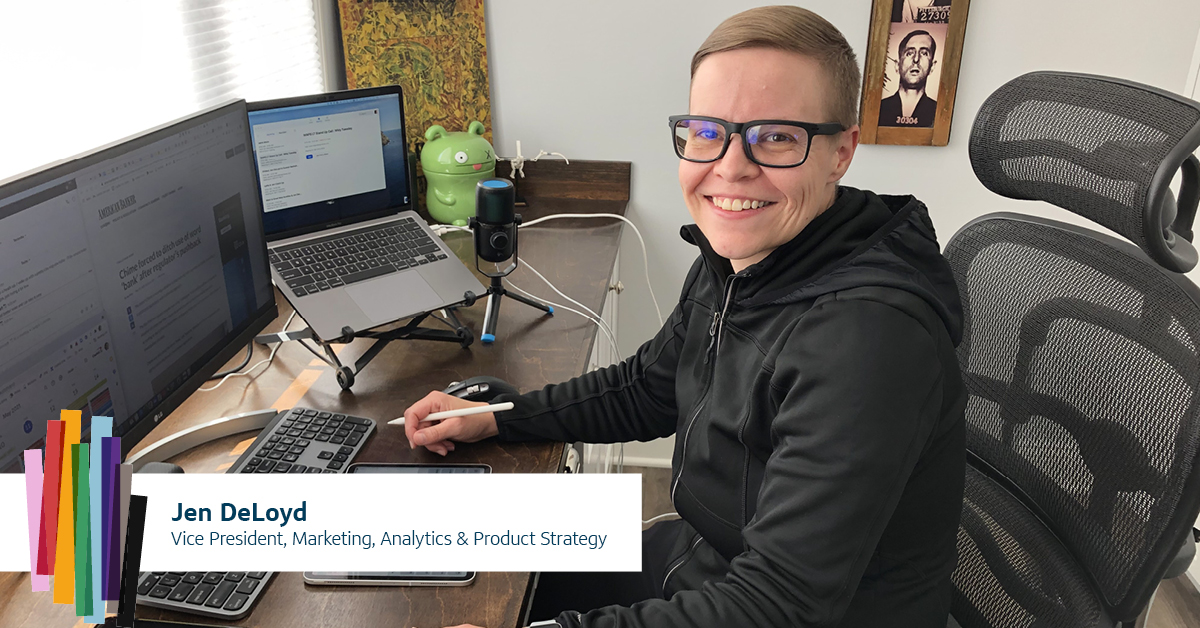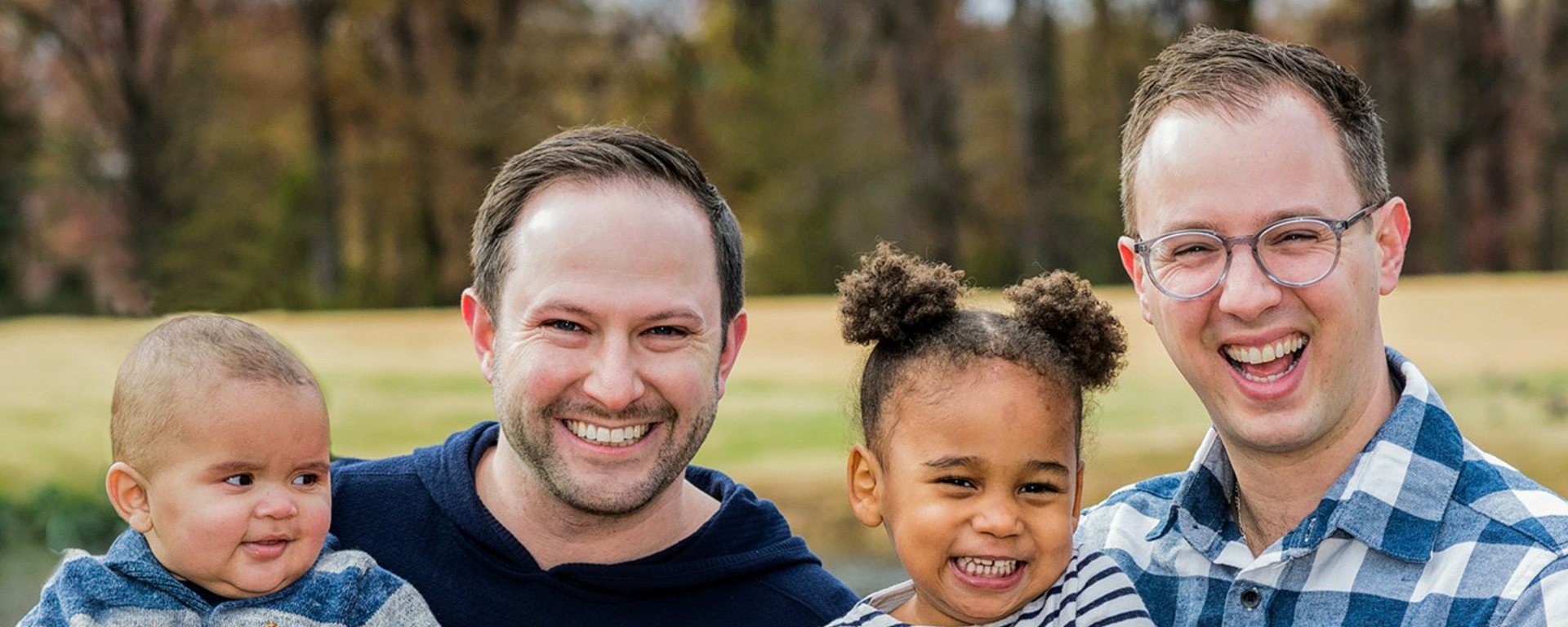Have you ever worked with a leader that inspired you to bring your full self to work and express your unique ideas freely? If you have, you know it creates a refreshing and more productive environment for collaboration and innovation. For leaders who identify as LGBTQ+, there can be a strong hesitation to openly share themselves fully after many years of social pressure to remain in the closet. For Capital One leaders Andy, Allison and Jen, being out and sharing their full identity freely in the office has helped them not only thrive in their work, but also create more inclusive spaces for their teams and help Capital One drive changes across a wider variety of associates in the organization.
Creating inclusion at work: Perspectives from LGBTQ leaders

Allison Perkel
Allison has spent most of her tech career in the Boston area building such diverse products as heart pumps, bomb disposal robots, databases, and security software. She has a BSEE and MSCS from Tufts. As she’s gotten older, she’s found that she has a need to be more visible and active so that she can help change societal norms. Progress isn’t always visible but we need to keep pushing forward.

Jen DeLoyd
Jen is a strategist, operator and executive, with a career spanning management consulting, early-stage growth companies, and investment management. She and her wife Julie live in Connecticut with their kids Eaden and Lennox, and rescue dog Loki. Jen joined Capital One in late 2020 and leads Payments, Analytics, Customer Experience and Consumer Insights for the Retail and Direct Bank.

Andy Ramamoorthy
Andy is a results-oriented executive with 20+ years of broad experience in financial services, banking and consulting. His roles have spanned strategy and analysis, product management, sales effectiveness, operations management, customer experience, post-merger business integration, and large-scale business transformation efforts.
Inclusive workplaces shape authentic leaders
Much of the work these leaders do at Capital One is centered around innovation and finding new and more effective ways to tackle the problems our teams and customers face. For Jen, this commitment to continually evolving is what brought her to Capital One in late 2020. After coming from a variety of industries and professional settings, Jen shared that she wanted a place “that obsesses about the ‘how’ of getting to outcomes just as much if not more than the outcomes themselves.”
A huge part of the “how” that goes into outcomes is diversity of thought among associates. The best way to cultivate diversity is through an open, inclusive culture where associates and leaders can be themselves freely and wholly without the concern of judgement. Allison shares that is one of the things she loves most about Capital One. She explains, “Capital One is a place where I can bring my true self to work every day. We are a company built around doing the right thing and we constantly strive to be better and make the world around us better.”
No one knows this better than Andy, who has spent the past 21 years innovating and evolving his career at Capital One. He shares, “I love the people I work with and have found great friendships. The company has undergone a dramatic transformation in 21 years. I didn’t even have to leave the company to do something different and build new skills. I feel challenged in my work, I don’t feel like I’ve ever stopped learning since being here.” In a company that cares about its employees’ development and growth, people can build lasting careers where they’re continually growing their skills and knowledge and finding new ways to help the company succeed.
Leading by example and bringing their full self to work
“What I love about Capital One is that we know if we keep doing the same things, nothing changes so we are willing to be inventive in how we support people, recruit people, and include people. We aren’t perfect and we’re constantly working to be better. That’s what I want from a workplace,” explains Allison. Creating a positive, inclusive space for teams to do their best work starts with leadership and how they show up or present themselves at work. By being their full and authentic selves, these leaders are able to model a positive work environment and encourage others to live and share their truths in the workspace and within their teams.
Each of these leaders has a story of a time in their early careers when they thought they couldn’t be their whole selves with their teams for fear of judgement and exclusion. But eventually, they found out that by being open and honest, they received support and acceptance, making a positive impact on team cohesion. Andy shared, “When I came out, there weren’t many out associates at Capital One. But I had an incredibly supportive manager who made all the difference—it only takes 1 person for you to feel comfortable. They opened the door for me and helped create safety for me to be my authentic self.”

Embracing authentic leadership
This support and encouragement had a profound impact, not just on Andy and his work, but all of those he came into contact with and worked with after that moment. He continues, “I had no more baggage of trying to be something I’m not, which takes a lot of emotional energy. Putting that behind me created space for me to be a better leader, friend, advocate, and performer. It gave me a chance to have more conversations with people and a platform to play a role in opening the door for other people going through their own journey at work.”
Jen has a similar approach to authentic leadership. She sees the value of being her full self at work for her own comfort, and as a role model for others around her. She explains, “The cognitive load of trying to fit in or play a part does nothing but detract from people’s ability to take risks and be creative in how they try to find solutions to business challenges.” She also knows that without diversity and unique experiences, the quality of work ultimately suffers. She added, “If we all act the same way and think the same way, there’s nothing meaningful to be gained by collaborating. If everyone brings their unique perspective, skills and style to bear, then we all have something to gain by pushing each other’s thinking in different ways.”
Building trust and inclusion
There’s another important aspect of team dynamics that honesty and openness about yourself can bring—trust. Allison learned this first-hand in a previous role. She remembers, “I used to be closeted at one company because I thought they’d treat me worse if they knew I had a wife. Turns out I was wrong and my relationship, and trust, with my coworkers became so much greater after I told them. I was able to trust that we’d have each other's back—that we could make mistakes around each other and help each other recover. That feeling led to better designs, architectures and products.” When teams are open and accepting of each other as they are, it allows everyone to also feel more connected and comfortable working closely together, freely sharing thoughts and ideas. This leads to some pretty great outcomes for the work they do.
For Jen, this trust and openness also included engaging in and opening herself up to honest and possibly uncomfortable conversations with her colleagues and teams. She explains, “Sometimes that means leaning in to difficult conversations about upsetting public events, or being open and vulnerable with them about my own personal situations, and sometimes it means calling out things I see in the moment (e.g., questioning whether a particular business process or decision has confronted potential implicit biases).”
When we trust our teams and leaders, we’re putting our faith in others to help create a level playing field. This includes leaders looking inward to identify things that may be affecting their fairness in leadership. According to Andy, a leader is “someone who listens... someone who does the best they can to create an inclusive environment, and makes an effort to create a team that reflects the broader communities that we all serve.” Embracing diversity and actively seeking to recognize and confront their biases is one of the best ways for leaders to build winning teams.

How can allies support their LGBTQ+ friends and colleagues?
All of these leaders recognize the importance of allies and those willing to stand up and support those around them who need advocates. In order to create equality, we all must work towards it and be prepared to change our normal patterns to include everyone. As Jen notes, “Ally is a verb—it’s a continuous action not a label, and having allies at all levels taking action with simple everyday efforts makes a huge difference, such as including preferred pronouns in your introductions, email signatures and Zoom handles even if you are cisgendered.” Some other suggestions she offers are also simple fixes that have a huge impact. For example, be aware of the language you use and assumptions you make when discussing life with coworkers. Jen explains, “It’s critical to be aware of the gender and hetero-normative ways people often try to connect with colleagues, like saying ‘wife’ or ‘husband’ when someone mentions being married, asking about Mother’s or Father’s Day celebrations, asking if kids are sons or daughters.” By recognizing our own biases and using more inclusive language, we are planting the seeds for a workplace where associates and leaders feel accurately seen and appreciated.
How else can you become a strong ally? Allison sums it up perfectly, saying “Allyship has so many forms but there is a quote that resonated with me—Allyship is earned and it can go away. You can’t declare yourself an ally. So how does one earn allyship? The big thing is listen first.” Take your cues from those around you and hear what they are saying, what their struggles or difficulties are and ask how you can help them in their journey. Andy also echoed this sentiment saying, “To me, being an ally is about recognizing that everyone is going on their own journey. Empathy doesn’t cost you anything, but goes a long way to unlock potential that everyone shares.”
All of these leaders have had a unique journey in their careers and their personal lives. Their experiences have varied quite a bit, but one thing remains true across each of their stories: the confidence and care they have put into living authentically and ensuring that they use their leadership platforms to help others thrive and find acceptance in the workplace. Through their inspiration and guidance, many associates can and will find the space to thrive and encourage others to do the same.
Related Content
-

Advocating for LGBTQ associates with Out Front
Discover how Capital One supports the LGBTQ community with the Business Resource Group, Out Front.
-

Pride in practice: Why I’m all in on Diversity, Inclusion & Belonging
Why is Rolddy Leyva passionate about diversity, inclusion and belonging? Read how his personal journey to live authentically has helped shape his work in creating an inclusive workplace.
-

How adoption and parental benefits helped create a family of four
For Ethan, it was a journey to create the family of his dreams. He used adoption benefits and relied on the support of his team to make it a reality.
All Jobs
- Senior Manager, Software Engineer R186186
- Senior Software Engineer, Full Stack R186185
- Lead UI Designer (Premium Design Team) R183120
- Senior Associate, UI Designer (Premium Design Team) R181040
- Senior Manager, Product Management - Prometheus Financial Core (PFC) R184723
- Senior Software Engineer, Full Stack R186180
- Senior Software Engineer, Back End (Java, Python, AWS) R185788
- Lead Software Engineer, Back End (Python / Go) R186177
- Sr. Software Engineer (Backend) R186159
- Senior Data Engineer R186167
- Senior Software Engineer, Back End R183393
- Senior Software Engineer, Authentication R186162
Copyright © 2024 Opinions are those of the individual author. Statements are deemed accurate at the time of posting. Unless otherwise noted, Capital One is not affiliated with, or endorsed by, any company mentioned. All trademarks and intellectual property used or displayed are the property of their respective owners.

